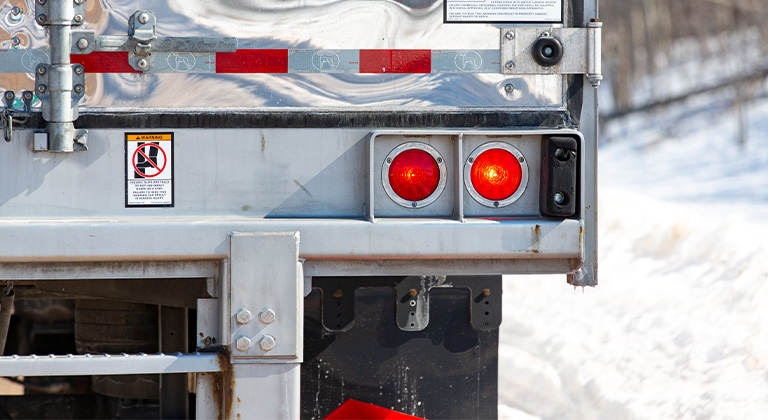What causes truck accidents?
Trucking accidents can happen quickly—for many different reasons. While trucking accidents have decreased over the last two years, it’s important for truck drivers and others on the road to know the potential hazards and how to help avoid them.
Let’s take a look at common causes of trucking accidents and how drivers and employers can help combat them.
Five common causes of truck accidents
Distracted driving
From cellphones to food and drinks, distractions are an issue for anyone behind the wheel of a vehicle—and something that everyone has a role in combatting.
Driver fatigue
Truck drivers in particular are on the road for hours at a time—many times overnight. Fatigue impairs judgment and reaction time, increasing the risk of an accident. It’s up to all drivers to recognize when they’re too tired to drive and take steps to stay rested and focused. And it’s up to employers to reinforce safe habits and industry guidelines for rest periods.
No zones
No zones—also known as truck blind spots—are specific areas on the road that truck drivers can’t see because of the size of their vehicles. If you’re driving in one of these zones, the truck driver won’t be able to see you, creating circumstances where an accident is more likely.
Speeding
Speeding impairs the driver’s ability to react to unexpected road conditions or traffic changes. It can be especially dangerous for truck drivers or other drivers navigating around semis.
Trucks take about 40% longer to come to a complete stop than passenger vehicles, which means truck drivers and others need to help ensure there’s enough time and distance to allow a safe stop.
Incorrect cargo loading
When cargo isn’t loaded or secured properly, it can shift during transit—making it harder for a truck driver to control the vehicle. Proper training, procedures, and inspections are essential to help ensure cargo is loaded safely every time.
Tips to help avoid trucking accidents
What drivers can do to help avoid truck accidents
Whether you're behind the wheel of a semi-truck or a compact car, staying safe on the road starts with smart, attentive driving. Keep these tips in mind to help protect yourself and others on the road:
Stay focused. Avoid distractions like texting, making phone calls, eating, or adjusting your GPS while driving. As mentioned above, distracted driving is a common cause of truck accidents.
Be aware of no zones. For non-truck drivers, it’s important to understand where a truck’s no zones—or blind spots—are and stay out of them whenever possible. For truck drivers, be aware of the traffic around you. Other drivers can enter your blind spots quickly. Give plenty of notice when turning, changing lanes, or stopping so other drivers have time to move out of the way.
Maintain safe distances: Give trucks and other vehicles plenty of space to maneuver and stop safely. Following too closely can easily cause an accident if another vehicle needs to make a sudden movement. This is especially true when semis are involved—know the proper truck following distance.
Maintain safe driving habits: Obey speed limits, use turn signals, and adjust your driving for weather and traffic conditions. These may seem like common sense practices, but even something as small as forgetting to use your turn signal can cause an accident.
Inspect your vehicle: Before hitting the road, check your tires, lights, brakes, and mirrors to help ensure everything’s working properly. Again, even minor factors can cause accidents.
What employers can do to help avoid truck accidents
By creating a culture of responsibility and supporting drivers with the right tools and practices, employers can have a proactive role in safe driving. Start with these steps:
Lead by example. Avoid calling or texting your drivers when they’re likely behind the wheel. Model the same focused-driving behaviors you expect from your team.
Hire carefully. Prioritize safety from the start by reviewing motor vehicle records (MVRs) and screening candidates for responsible driving history. Also check the MVRs of current drivers on an annual basis.
Build a strong safety program. Implement proactive safety policies, ongoing training, and clear expectations around safe driving practices. Safety policies around cellphones are especially important. At Sentry, our Safety Services team can help you develop a program that works for your business.
Inspect trucks carefully. Make sure trailers are in good shape and loads are properly secured before a trip. Check brake lights, tires, and other vital parts before leaving.
Invest in telematics. Telematics technology can provide valuable insights into driver behavior, vehicle performance, and potential risks—helping you take proactive steps to improve safety.
If you’re involved in a trucking accident, we make it easy to file a claim, whether you’re a first- or third-party claimant.
Related resources
How to file a trucking accident claim
Learn how truck accident claims work—including how they differ from car accidents, and how you can help ensure a smooth process.
Trucking safety policies and accident procedures
Truck drivers and their employers can take certain steps to help ensure safety on the road. Know how to help reduce accidents—and how to respond if one does happen.
What to do if you’re in an accident with a truck
If you're involved in an accident with a truck or other commercial vehicle, responding appropriately can help keep the involved parties safe—and also help expedite the claim process.




